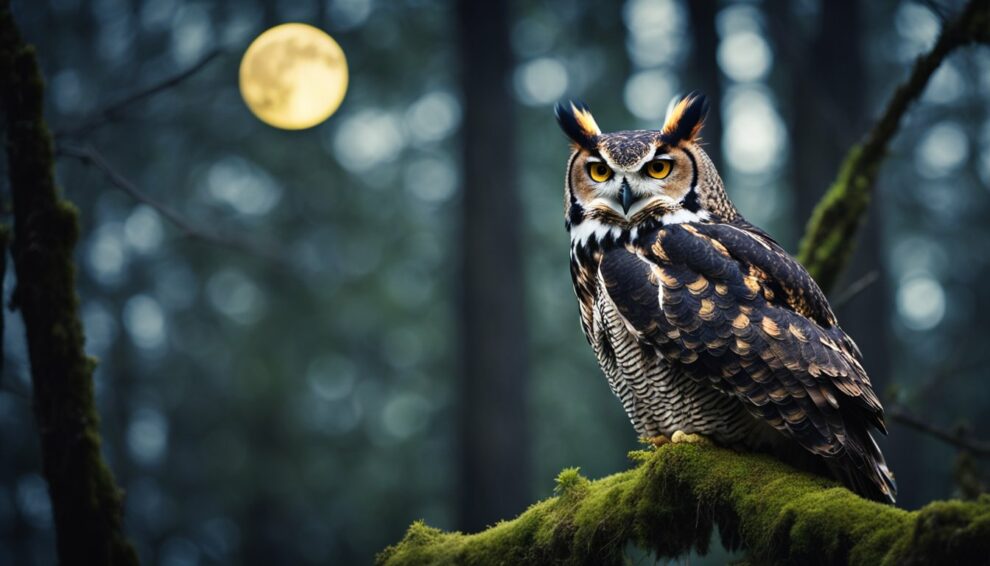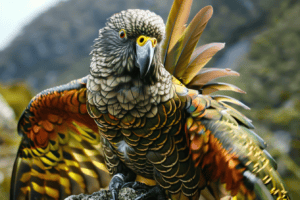The great horned owl, often seen as a symbol of wisdom in folklore, is truly a master hunter of the night.
With their impressive wingspan and silent flight, these birds are the stealthy rulers of the dusk.
They inhabit a variety of ecosystems across North America, from deserts to wetlands, making them one of the most versatile predators in the avian world.
At up to two feet in length, with a wingspan of over four feet, their size alone commands respect.
But it’s not just their stature that makes them formidable; their sharp talons and beak are perfectly designed to catch and consume their prey.

As night falls, these owls embark on their quest for food, using their excellent night vision and acute hearing to locate prey.
Small to medium-sized mammals, like rabbits and rodents, are on the menu, but the great horned owl doesn’t stop there.
They are known to take on birds, including other owls, hawks, and even larger prey, showcasing their prowess as apex predators of the night.
Imagine walking through the forest at night and hearing the deep, resonant hooting of the great horned owl.
The sound carries through the trees, adding to the mystery of these nocturnal creatures.
They communicate with each other using a series of hoots, especially during mating season.
Beyond their incredible hunting abilities, these owls play an essential role in their ecosystems by controlling rodent populations, which helps maintain a balanced environment.
Did you know that despite their name, the “horns” are simply tufts of feathers?
These tufts make them one of the most recognizable owls, often depicted in books and movies as the wise old guardian of the forest.
Unveiling the Hunter of the Shadows
At night, while the world is quiet, the Great Horned Owl embarks on a stealthy expedition.
With its incredible hunting skills, this bird epitomizes the masterful nocturnal predator.
Mysteries of Nighttime Hunting
The Great Horned Owl exercises extraordinary hunting tactics under the cloak of darkness.
Using acute hearing and sharp vision, it locates prey in near-total darkness.
As night falls, the scene is set for the owl to commence its silent aerial pursuit. It swoops down with precision, catching unsuspecting prey.
Silent Wings and Stealthy Talons
The owl’s feather structure allows for nearly soundless flight—imperative for stalking prey.
The edges of the feathers are serrated, breaking up airflow and muzzling the swish of wings.
This silent flight ensures they remain undetected until it’s too late for the quarry.
Once in range, the Great Horned Owl deploys razor-sharp talons, delivering a powerful, precise strike.
The Owl’s Varied Menu
What’s for dinner? For a Great Horned Owl, the menu may include rodents, larger mammals, and even other birds.
Reptiles, insects, and amphibians also round out its diet, showcasing the owl’s adaptability.
This varied diet is evidence of its role as an apex nocturnal predator within its ecosystem.
The Circle of Life

The majestic Great Horned Owl navigates a complex life cycle, from its beginnings as a vulnerable egg to its reign as a masterful predator.
The owl’s journey is a tale of growth, instinct, and adaptability within the often-harsh realities of the wild.
From Egg to Predator
Beneath the canopy of the forest or in the cavities of a cliff, a pair of Great Horned Owls selects a suitable nesting site to lay their eggs.
Typically, two to three white eggs are laid, with the young called owllets emerging after 30 to 37 days of incubation.
The downy fledglings are born blind and helpless, dependent on their parents for warmth and food.
These early stages are critical, and survival hinges on the vigilant care of both parents who fiercely protect and feed their brood until they develop into skilled hunters themselves.
Breeding Season Customs
During breeding season, which may range from January to February, Great Horned Owls are engaged in a symphony of hoots to establish territory and attract mates.
Once bonded, a pair may use the same nest annually, refurbishing it with feathers, bark, and downy materials.
The female typically takes responsibility for incubation, while the male hunts and delivers food.
This division of labor ensures that the nesting period is successful and that the next generation will be ready to face the challenges of their environment.
Navigating Natural Challenges
The life cycle of the Great Horned Owl is not without its barriers.
Predators such as eagles and larger owls pose a threat to eggs and young, making the choice of a secure nesting location a crucial decision.
Moreover, habitat loss and human impacts have presented new challenges for owl populations.
Yet, with their remarkable adaptability, these owls continue to thrive across diverse habitats – from arid deserts to lush forests.
Conservation efforts play a significant role in maintaining healthy ecosystems for these owls to carry out their essential role in the balance of nature.
While the Great Horned Owl faces numerous obstacles throughout its life, its resilience and adaptability allow it to overcome them, playing a crucial role in the ecosystem as an apex predator.
As each owl matures from vulnerable hatchling to a sovereign hunter, they continue to fascinate and inspire those who are lucky enough to witness their journey.
The Echoes in the Forest

Deep in the heart of the forest, when the sun dips below the horizon, the Great Horned Owl’s presence is announced not by sight, but by the mystical sounds it produces in the nighttime air.
Calling into the Night
The Great Horned Owl communicates using an array of hoots and calls, each serving a purpose in the tapestry of their nightly endeavors.
Hearing the deep, resonating “hoo-h’Hoo-hoo-hoo” in the quiet of the forest can be both thrilling and a little eerie.
This signature sound is often used for courtship or solidifying the bonds between mated pairs.
Each call acts like a sonic beacon, carving out territories and warding off potential rivals with a proclamation of ownership.
Decoding the Owl’s Communication
Scientists have interpreted these vocalizations, distinguishing between the soft hoots used for communication with chicks and the piercing calls that can signal aggression.
The owl’s ears are fine-tuned for detecting even the subtlest rustles of prey.
Their asymmetrical placement on the head creates a superlative sound localization ability, allowing them to pinpoint the exact location of sounds in total darkness.
With such powerful hearing, these formidable predators can effortlessly glide to their next meal, guided by the echoes in the forest.
Guardians of the Ecosystem

In the shadowy realm of the night, the Great Horned Owl serves as a vigilant steward of balance within the ecosystem.
These raptors play a crucial role in maintaining the delicate equilibrium of nature.
The Owl’s Role in Nature
Imagine the forest as a grand tapestry, with every creature a thread contributing to the overall beauty.
The Great Horned Owl is like a master weaver in this scenario, ensuring that no single thread unravels the fabric.
As apex predators, they help control the population of rodents and other small mammals.
This isn’t just a midnight snack for the owls; it’s a way to keep these critter numbers in check, thereby preventing widespread damage to crops and vegetation.
By doing so, they sustain the health of their habitats, making sure every organism has a fair chance to play its part.
You might wonder what happens when owls hoot into the night.
Well, that sound does more than just echo through the darkness; it helps mark their territory.
This natural boundary-setting keeps the ecosystem from being overrun by too many predators of a single species.
And since these owls can adapt to almost any environment—forests, deserts, and even cities—they’re everywhere, working their magic to stabilize the ecological balance.
Conservation Efforts and Human Impact
The tale of the Great Horned Owl is not complete without humans in the picture.
Some humans have recognized the owl’s ecological importance and the need to preserve it.
Conservation efforts range from legal protections to the creation of wildlife reserves.
For instance, places where owls choose to nest and hunt are safeguarded, ensuring they have a safe home and plenty of food.
Sadly though, not all human interactions are helpful. Habitat destruction and pollution pose threats to the survival of these birds.
But on a brighter note, more people are stepping up to help by participating in studies and supporting policies that protect natural areas.
Ever thought about how you could help an owl? Simple things like reducing pollution and supporting conservation groups can make a huge difference.
Can you imagine a world without these guardians of the ecosystem? It would be like a puzzle missing pieces—never quite complete.
The Great Horned Owl not only mystifies us with its haunting gaze and silent flight but also reminds us of our responsibility to nature.
They are not just birds; they are integral threads in the tapestry of life, and it’s up to us to ensure that tapestry remains whole.
Frequently Asked Questions

The secretive life of the Great Horned Owl raises many questions about how it thrives in the darkness.
From its hunting tactics to its role in the ecosystem, let’s explore the intriguing details about this nocturnal bird of prey.
How does the great horned owl hunt its prey during the night?
The Great Horned Owl utilizes its excellent night vision and acute hearing to locate prey in the dark.
Once it zeroes in on a target, it swoops down silently, thanks to the specialized design of its feathers, to capture its meal with powerful talons.
What adaptations make the great horned owl such an effective nocturnal predator?
Two feet in length with a wingspan of 4 and a half feet, the Great Horned Owl is equipped with sharp beak and strong talons for hunting.
The fringed edges of its wings enable silent flight, crucial for sneaking up on its prey, while its remarkable eyesight and hearing are finely tuned for night hunting.
How do great horned owl chicks learn to hunt and survive in the wild?
Chicks learn from observation as their parents demonstrate hunting techniques.
Initially, parents provide food, but as the chicks grow, they practice with prey brought to the nest. Gradually, they must hunt independently to survive.
What are some threats to the great horned owl’s habitat and existence?
Habitat destruction and human encroachment pose significant risks to their environment.
Additionally, pesticides can harm their food sources, inadvertently affecting the owls through secondary poisoning.
How can we identify a great horned owl and differentiate it from other owl species?
The Great Horned Owl can be recognized by its prominent ear tufts, intimidating yellow eyes, and deep hooting voice.
This distinct appearance, along with its size and the pattern of its feathers, sets it apart from other owls.
In what ways do great horned owls contribute to the ecosystem they inhabit?
These owls play a crucial role as apex predators, managing populations of rodents and other small animals.
Their presence maintains the balance in their habitat, showcasing the interconnectedness of ecosystems.









